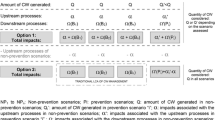Abstract
Purpose
The objective of this case study is to identify the relevant processes needed in the environmental assessment of the end of life of a building and to identify the demolition process variables that significantly affect energy consumption and emissions of greenhouse gases. Different scenarios of demolition, based on three alternatives for managing construction and demolition waste (C&DW) generated during demolition works, are analyzed. This study is based upon typical construction and demolition practices and waste management in Spain.
Methods
Life cycle assessment (LCA) methodology is applied to assess objectively and quantitatively different C&DW management plans during the design phase and to identify the significant environmental aspects. The impact categories considered are global warming potential and human toxicity potential. Furthermore, the indicator primary energy (non renewable energy from fossil fuels) is also studied.
Results
Design of C&DW management plans to enhance the recovery of waste, reducing significantly the selected environmental indicators, was assessed in this study. Waste transport from the demolition work to the treatment plant and the transport of the non-recyclable fraction to the final disposal, as well as the fuel consumption in hydraulic demolition equipment and in the loading/unloading equipment of the treatment plants, are the most significant environmental aspects associated with the management plan based on a selective demolition, whereas in a conventional demolition process, the main environmental aspect is waste transport from the demolition work to final disposal.
Conclusions
LCA studies allow an assessment of different demolition processes. A tool for recording environmental data has been developed. This tool provides in a systematic manner life cycle inventory and life cycle impact assessment of the end of life of a building, facilitating the study of management plans in the design phase.


Similar content being viewed by others

References
(ISO 14040:2006) Environmental management – Life cycle assessment – Principles and framework
Carvajal-Salinas E, Ramirez-de-Arellano-Agudo A, Rodríguez-Cayuela JM (1984) Clasificación Sistemática (Systematic classification). Fundación Codificación y Banco de Precios de la Construcción (FCBPC), Sevilla
CEIDARS (California Emission Inventory Development and Reporting System) (1999) Speciation profiles and size fractions. California Air Resources Board, California Environmental Protection Agency, USA
Doka G (2009) Life cycle Inventories of Waste Treatment Service ecoinvent report no. 13. Swiss Centre for Life Cycle Inventories, St. Gallen
Frischknecht R, Jungbluth N et al. (2003) Implementation of life cycle impact assessment methods. Final report ecoinvent 2000, Swiss Centre for LCI. Dübendorf, CH, www.ecoinvent.ch. Accessed 19 July 2012
Gestora de Runes de la Construcció (GRC) (2011) Localización instalaciones (Location of the facilities). www.grc.cat/localitzacio.php, (in Catalan). Accessed 19 July 2012
Guinée JB, Gorrée M, Heijungs R, Huppes G, Kleijn R, van Oers L, Wegener Sleeswijk A, Suh S, Udo de Haes HA, de Bruijn H, van Duin R, Huijbregts MAJ (2002) Life cycle assessment: an operational guide to the ISO standards. Kluwer, Dordrecht
Weidema B, Hischier R, Althaus HJ, Bauer C, Doka G, Dones R, Frischknecht R, Jungbluth N, Nemecek T, Primas A, Wernet G (2007) Code of practice. Ecoinvent report no. 2. Swiss Centre for Life Cycle Inventories, St. Gallen
IHOBE, Sociedad Pública de Gestión Ambiental (2004) Guía Metodológica para la elaboración de proyectos de demolición selectiva en la comunidad autónoma del País Vasco (Methodological guidelines for the development of selective demolition projects in the Basque Country). www.ihobe.net/Publicaciones/ficha.aspx?IdMenu=750e07f4-11a4-40da-840c-0590b91bc032&Cod=ed4b56b3-7788-44db-9e38-e9e0f003b6b9&Tipo=. (in Spanish). Accessed 13 March 2013
Maydl P (2004) Sustainable engineering: state-of-art and prospects. Struct Eng Int 3:176–180
Maydl P (2006) Structural sustainability—the fourth dimension? Struct Eng Int 3:268–269
Passer A, Kreiner H, Maydl P (2012) Assessment of the environmental performance of building: a critical evaluation of the influence of technical building equipment on residential building. Int J Cycle Asses 17(9):1116–1130
Prue K (2012) Promoting C&D recycling. One city’s odyssey to bring more C&D recycling to its area. C&D World July/August 2012:22–26. http://cdw.epubxp.com/i/75187/23. Accessed 13 March 2013
PSE CICLOPE Project (2012) Quantitative analysis of the life cycle environmental impact of buildings in terms of energy demand and associated GHG emissions. www.pseciclope.es. Accessed 19 July 2012
Solís-Guzmán J, Marrero M, Montes-Delgado MV, Ramirez-de-Arellano A (2009) A Spanish model for quantification and management of construction waste. Waste Manag 29(9):2542–2548
Spielmann M, Bauer C, Dones R, Tuchschmid M (2007) Transport services. ecoinvent report no. 14. Swiss Centre for Life Cycle Inventories, Dübendorf 2007
Wallbaum H, Meins E (2009) No sustainable planning, constructing and operating-(still) common praxis in the building industry for good reason? Bauingenieur 84:291–303
Acknowledgments
In this case study, data identified as significant during the development of the task T4.2. Environmental simulation/monitoring of demolition for data collection, of the sub-project 4 of the Singular and Strategic Project “Quantitative analysis of the life cycle environmental impact of buildings in terms of energy demand and associated GHG emissions, PSE CICLOPE Project (2012),” co-financed by the Spanish Ministry of Science and Technology and the European Regional Development Fund under the National Scientific Research, Development and Technological Innovation Plan 2008–2011 were extracted. Furthermore, the authors wish to thank iMat-Construction Technologies for its coordination and technical review of the project activities.
Author information
Authors and Affiliations
Corresponding author
Additional information
Responsible editor: Alexander Passer
Rights and permissions
About this article
Cite this article
Martínez, E., Nuñez, Y. & Sobaberas, E. End of life of buildings: three alternatives, two scenarios. A case study. Int J Life Cycle Assess 18, 1082–1088 (2013). https://doi.org/10.1007/s11367-013-0566-4
Received:
Accepted:
Published:
Issue Date:
DOI: https://doi.org/10.1007/s11367-013-0566-4



